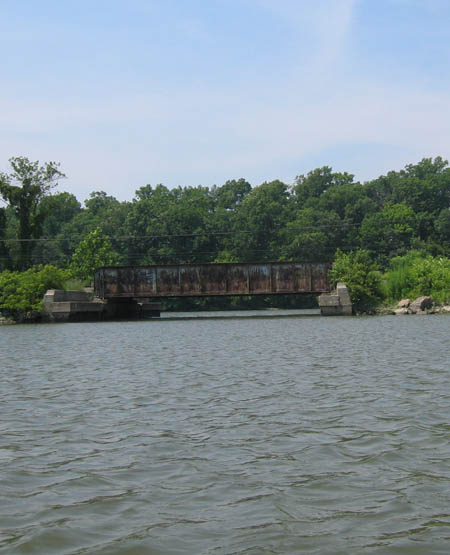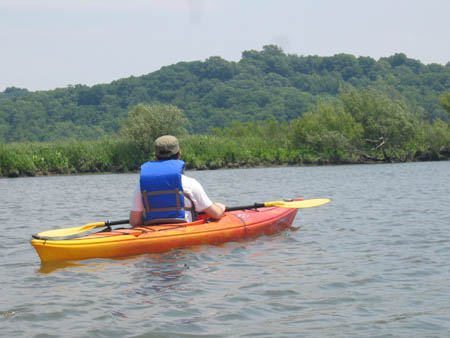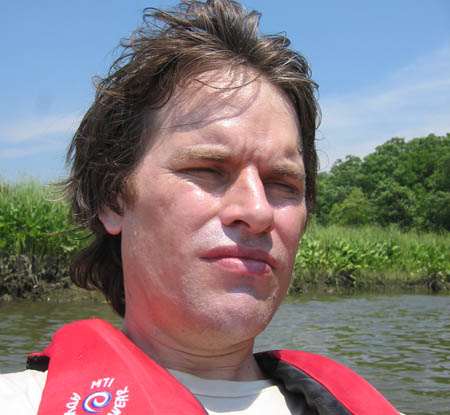|
|
|
kayaking on Tivoli Bay
Monday, July 9 2007
I don't know if it was the partial course of veterinary antibiotics or the healing power of Garlic Mustard seeds, but by this morning the pain that I'd thought was a abscessing wisdom tooth had mostly vanished, as had its disconcerting metallic taste. I decided not to make a dental appointment.
Meanwhile both nestling Phoebes were still alive, though one didn't seem to have strength enough to eat. Every time I fed them (or tried to) I'd end up having to kill four or five nest mites that had swarmed onto my arm either by climbing up the needle nose pliers (my parental "beak") or taking advantage when my arm brushed against the side of the hanging bucket where I was keeping the nest. The bucket had originally been to keep the birds safe from cats, but now its chief benefit was to slow the spread of nest mites into the laboratory. It turns out, though, that one doesn't have to worry much about bird mites; they never last long away from birds.
My friend "Mr. Tillson" (who is actually named Zelig) had been pursuing an educational degree at Bard and, having graduated from that program, is now actively seeking employment in a high school classroom near you (if you happen to live within thirty miles of Rosendale). Meanwhile he has to contend with a huge chasm of free time that has suddenly opened up in front of him, so today he found one way to fill some of it in. He arranged to go kayaking with me on Tivoli Bay, which is on east the side of the Hudson roughly across from Saugerties. Zelig has two kayaks, so all I had to do was show up. We met in the Hannaford parking lot in Uptown Kingston and, in search of junk food, I dove into the ice-cold lake that Hannaford is on a hot humid summer day. The problem with shopping for junk food in a grocery store is that it is too rarified in the intervening vacuum of non-junk food. In a gas station, your junk food options are often crammed into a couple aisles and it's easy to wrap your brain around the available diversity in a few seconds. In a supermarket, trying to do so is exhausting. In the end I took advantage of the cognitive shortcuts that Hannaford makes available to the hurried. I saw a huge pile of Cheese Nips, a species of junk food about which I'd completely forgotten. I grabbed a box of that (the white cheese flavor, since I harbor unfounded suspicions about yellow cheese) as well as a bag of guacamole-flavored Garden of Eatin' corn chips, a representative from the other side of the junk food tracks.
Zelig and I parked at a Hudson River landing near the Victorian houses of "downtown" Tivoli and paddled south towards the bay. I'd never been in a kayak before and found it faster and more responsive than a canoe, though I had difficulty paddling without occasionally wanging my knuckles on the side of the boat. The key to effective kayak paddling seems to be keeping the fulcrum of the paddle at about chest level, but holding arms at this level for long periods of time eventually becomes exhausting regardless of the forcefulness of the paddling, similar to doing electrical work in ceilings.
The kayak I was using had a relatively wide cockpit hole, large enough for a serene dog to accompany the paddler. This made it easier to carry stuff, but it made a bigger target for spray. The surface of the Hudson was choppy enough that water would occasionally splash over the lip of the kayak, though little accumulated. My main concern was my digital camera, and, once open, the box of Cheese Nips (eating them again after all these years was, in some small way, like returning from a stint in a monastery).
It didn't take long to paddle down past the ruins of a dock to the bay, whose mouth was cut off from the river by a causeway carrying a pair of Amtrak tracks connecting Montreal and New York City. There was a low bridge in the causeway permitting water to flow out of the bay and kayakers (but not motorized boats) to paddle in. Tivoli bay is a marshy lowland cut by a maze of open channels, each about fifty feet wide. Most of the vegetation appears to be cattail and water plantain. We also saw Blue Herons, Red-Winged Blackbirds, and a large species of grebe that could swim like a frog but flew away only reluctantly (and, dare I say, clumsily).
After an unsuccessful hunt for the creek supplying fresh water to the bay, we paddled back out into the Hudson and landed on the east coast of Magdalen Island, a ten acre bedrock island that is part of the Tivoli Bay Wildlife Management Area. It was a very Huckleberry Finn sort of place, where one could imagine finding pirate treasure or Lord-of-the-Flies-style spontaneous feudal societies. Indeed, the island was posted with signs forbidding digging and the taking of artifacts. I went on a reconnaissance mission to the island's west coast (some 200 feet away from its east coast across a low stony ridge) and found a bedrock beach with a fire pit containing some beer bottles, but otherwise the island was surprisingly pristine. Throughout the woods were many pits about ten feet wide and three feet deep, perhaps the result of ancient archæological banditry. At first I expected to find old growth forest on the island, but what a silly notion! The timber on this island had been some of the most accessible and poorly-guarded in all the Hudson Valley. Its trees had probably been among the first felled and floated downriver.
From the Magdalen Island beach, Zelig and I skipped stones for awhile, trying to skip absurd shapes and big flat sheets of bedrock. At some point I discovered that among the muck-covered pebbles of the beach there were many antique iron nails. Some were as long as three inches and they were all square in cross section. Violating the artifact mining ban, I pocketed every one I found.
Paddling back to the Tivoli landing where we'd launched, we had a stiff south wind at our backs and the swells seemed to drive us forward. We may have also been the beneficiaries of a returning tide, which had seemed to bottom out during our stop on Magdalen Island.
Both baby Phoebes were still alive when I returned home, though only the strong one had the strength to raise its head and accept food. By nightfall the weaker of the two had stopped moving and was clearly dead. I knew this would happen and I knew the other would die too, but for some reason I couldn't bear the thought of them dying completely abandoned.

Zelig passes a Blue Heron north of Tivoli Bay, heading south.

The railroad bridge in the Amtrak causeway separating the Hudson from Tivoli Bay.

Zelig in Tivoli Bay.

Self-photography.

Zelig along a hillside on the eastern edge of Tivoli Bay.

The Loch Ness Monster? No, a grebe in Tivoli Bay.
For linking purposes this article's URL is:
http://asecular.com/blog.php?070709 feedback
previous | next |





